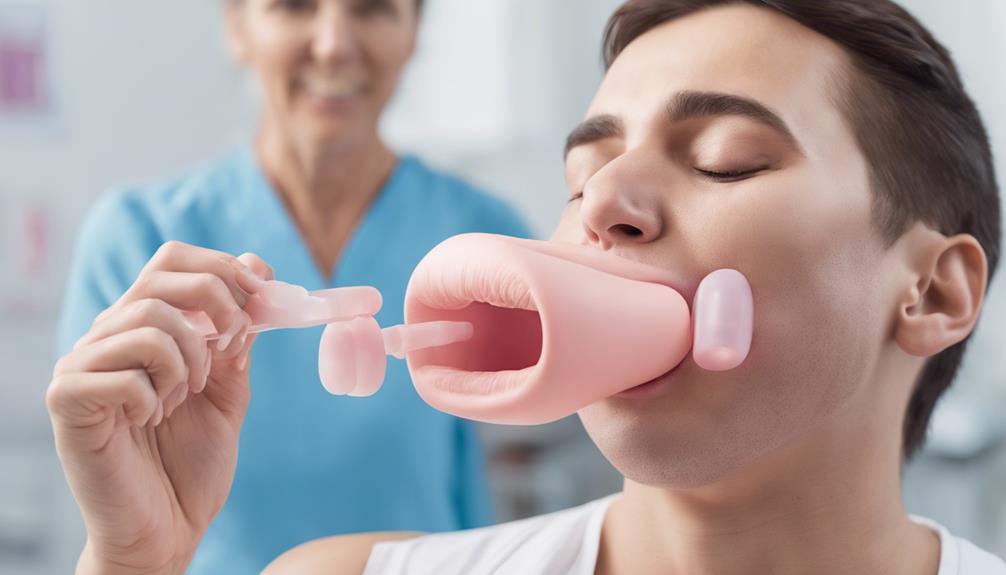As we step into the world of speech therapy for swallowing difficulties, imagine a delicate dance between muscles, nerves, and coordination essential for a basic human function.
The intricacies of addressing dysphagia through therapy involve not only identifying the root causes but also tailoring interventions to strengthen and improve swallowing capabilities.
From exercises targeting specific muscle groups to personalized treatment plans, speech therapists navigate a path towards enhanced swallowing function.
Curious to uncover the various techniques and approaches utilized? Join us in exploring the multifaceted realm of speech therapy for swallowing difficulties.
Key Takeaways
- Speech therapy addresses swallowing difficulties through specialized techniques.
- Techniques focus on enhancing muscle function in oral and upper gastrointestinal areas.
- Personalized plans ensure safe and effective progress in swallowing function.
- Speech therapists conduct assessments to identify swallowing issues and tailor interventions accordingly.
Understanding Swallowing Difficulties
Understanding swallowing difficulties can be crucial in identifying and addressing the challenges individuals may face with their ability to swallow food and liquids effectively.
Swallowing disorders, also known as dysphagia, can stem from various conditions like neurological disorders, stroke, Parkinson's disease, and head injuries. Symptoms of dysphagia, such as painful swallowing, feeling of food stuck in the throat, drooling, hoarseness, and chest discomfort when eating, can significantly impact a person's quality of life.
Speech therapists play a vital role in managing swallowing issues through customized treatment plans and specialized techniques. They conduct swallowing exercises and train throat and mouth muscles to improve swallowing function. Techniques like suction exercises with a straw, dry swallowing to strengthen muscles, and coordination exercises targeting muscle groups involved in swallowing are commonly used in therapy sessions.
Seeking speech therapy services at facilities like Bladen East ensures access to quality care and collaborative support from healthcare professionals, ultimately enhancing individuals' overall quality of life through rehabilitation services.
Role of Speech Therapists

As speech therapists, we bring our specialized training and expertise to the table when addressing swallowing difficulties.
Our techniques aim to improve muscle function in the oral and upper gastrointestinal areas, enhancing swallowing abilities.
We work closely with individuals to create personalized plans that ensure safe and effective progress in their swallowing function.
Therapists' Training and Expertise
With a master's degree in speech-language pathology, speech therapists possess specialized training to effectively address swallowing difficulties among individuals. They're state-licensed professionals with expertise in treating swallowing problems. Additionally, speech therapists may pursue certification from reputable organizations such as the Speech Language Therapy Association of America to further enhance their skills. Their knowledge extends to assessing and treating oral motor function, swallowing disorders, and communication challenges. Through close collaboration with patients, speech therapists develop personalized treatment plans aimed at improving swallowing function.
- Master's Degree: Speech therapists hold a master's degree in speech-language pathology.
- State Licensing: They're state-licensed professionals with specialized training in treating swallowing difficulties.
- Certification: Speech therapists may also obtain certification from organizations like the Speech Language Therapy Association of America.
- Expertise: Their expertise involves assessing and treating oral motor function, swallowing disorders, and communication challenges.
Techniques for Improvement
Upon assessing swallowing difficulties, speech therapists employ specialized techniques to enhance muscle strength and coordination for improved swallowing function. Speech therapists focus on the muscles used for swallowing, such as those controlling the tongue and throat. They design exercises to improve these muscle groups, like tongue thrusting movements and swallowing exercises.
Additionally, therapists may recommend oral devices to aid in oral stimulation and coordination, leading to better swallowing abilities. To assist with liquid intake, they might suggest thickeners to make swallowing liquids easier.
Furthermore, speech therapists teach strategies like eating slowly, taking smaller bites, and maintaining proper posture to promote safe swallowing practices. Through customized exercises and solutions, speech therapists work diligently to enhance swallowing ability effectively and safely.
Swallowing Evaluation Process
During the swallowing evaluation process, speech therapists carefully assess oral and pharyngeal function to pinpoint any swallowing difficulties. This evaluation is crucial for individuals with conditions like muscular dystrophy, where swallowing function can be compromised. Here are the key components of the swallowing evaluation process:
- In-Office Assessments: Speech therapists often conduct tests like a modified barium swallow to visualize the process of swallowing and identify any abnormalities or difficulties.
- Muscle Movements Examination: Evaluating muscle strength and coordination in the oral and pharyngeal areas helps in understanding the mechanics of swallowing and identifying areas of weakness.
- Aspiration Risk Assessment: Speech therapists look for signs of aspiration, where food or liquid enters the airway instead of the esophagus, which can lead to serious health issues.
- Personalized Treatment Plans: The detailed evaluation results help in developing tailored treatment plans to address specific swallowing issues effectively.
This thorough evaluation process enables speech therapists to determine the severity and underlying causes of swallowing difficulties, guiding them in providing the best possible care and support for individuals facing these challenges.
Techniques for Swallowing Improvement

We understand the importance of swallowing exercises and the effectiveness of dietary modifications in improving swallowing difficulties.
By focusing on strengthening relevant muscles and adjusting dietary consistencies, individuals can enhance their swallowing function.
Our tailored techniques aim to optimize swallowing efficiency and promote safer eating practices for a better quality of life.
Swallowing Exercises Importance
Swallowing exercises play a crucial role in speech therapy by strengthening the muscles involved in swallowing and enhancing coordination for more effective swallowing. These exercises are vital for improving swallowing function, and here are some important points to consider:
- Tasks like using a straw and small paper pieces can help with suction practice.
- Dry swallowing exercises are commonly utilized to engage and strengthen swallowing muscles.
- Regular repetition of swallowing exercises can enhance muscle strength and function.
- Improved coordination of muscle groups through exercises leads to better swallowing abilities over time.
Dietary Modifications Effectiveness
Enhancing the safety and manageability of swallowing for individuals with swallowing disorders involves effective dietary modifications. Altering food textures and consistencies can significantly improve the swallowing process for those with dysphagia.
Thickening liquids is a common recommendation to reduce the risk of aspiration and ensure safer intake. Soft or pureed foods are often easier to chew and swallow, making them beneficial for individuals with swallowing difficulties.
Additionally, minced or finely chopped foods help prevent choking and facilitate swallowing for those with compromised swallowing function. Adjusting food temperatures, such as serving warm or cold foods, can enhance comfort and safety during the swallowing process.
These dietary modifications play a crucial role in improving the overall quality of life for individuals with swallowing difficulties.
Importance of Exercise in Therapy

Incorporating targeted exercises into speech therapy sessions is crucial for improving swallowing function in individuals with swallowing difficulties. These exercises focus on strengthening muscles involved in swallowing, such as the tongue, lips, and throat.
Here are four key points highlighting the importance of exercise in therapy:
- Enhanced Coordination: Swallowing exercises help improve coordination and control of swallowing muscles, leading to a safer swallowing process.
- Tailored Programs: Speech therapists customize exercise programs to target specific muscle groups and address individual needs, ensuring effective treatment.
- Muscle Strength: Regular practice of swallowing exercises results in increased muscle strength over time, contributing to improved swallowing function.
- Diverse Exercises: Including a variety of exercises like tongue exercises and throat muscle strengthening can significantly enhance swallowing outcomes for individuals with swallowing difficulties.
Diet Modifications for Swallowing

Making adjustments to one's diet can significantly aid in managing swallowing difficulties. When faced with swallowing issues, diet modifications play a crucial role in ensuring safe and efficient swallowing.
Altering food textures, such as opting for pureed or soft foods, can make swallowing easier and reduce the risk of aspiration. Thickening liquids using commercial thickeners is another effective strategy to help individuals with swallowing difficulties consume liquids more safely.
Additionally, practicing thorough chewing and taking small, manageable bites can further enhance swallowing function and decrease the chances of choking incidents. It's important to avoid hard, crunchy, or sticky foods that may pose challenges for those with swallowing difficulties.
Working closely with a speech therapist allows for personalized diet modifications tailored to meet individual needs, ultimately improving swallowing function and enhancing overall quality of life. By implementing these diet adjustments, individuals can navigate swallowing difficulties with greater ease and confidence.
Strategies for Overcoming Dysphagia

When facing dysphagia, our team focuses on effective swallowing techniques and dietary modifications to help individuals overcome swallowing difficulties.
We work on strengthening swallowing muscles and improving coordination to ensure safer swallowing experiences.
Effective Swallowing Techniques
To enhance swallowing function and overcome dysphagia, individuals can implement effective techniques such as adjusting posture for safer swallowing. Here are some additional strategies that can help improve swallowing difficulties:
- Utilize thickeners: Adding thickeners to liquids can make swallowing easier for individuals with dysphagia.
- Opt for smaller, frequent meals: Speech therapists may suggest consuming smaller and more frequent meals to better manage swallowing challenges.
- Practice mindful eating: Taking smaller bites and chewing thoroughly can enhance swallowing function.
- Engage in oral exercises: Strengthening swallowing muscles through specific oral exercises is a fundamental aspect of speech therapy for dysphagia management.
Dietary Modifications
Adjusting food textures and consistencies plays a crucial role in managing dysphagia, focusing on making swallowing safer and easier for individuals with swallowing difficulties.
Dietary modifications are essential in addressing swallowing difficulties. Thickened liquids are often recommended to prevent aspiration. Soft, moist foods like mashed potatoes and smoothies can reduce the risk of choking. Avoiding hard, dry, or sticky foods is crucial to prevent choking incidents and enhance the overall eating experience.
Chopping or pureeing solid foods, such as fruits and vegetables, can facilitate easier swallowing for individuals with dysphagia. By making these adjustments, individuals can enjoy meals more comfortably and safely, promoting better nutrition and overall well-being in those facing swallowing challenges.
Progress Monitoring in Therapy
Progress monitoring in speech therapy for swallowing difficulties involves utilizing standardized assessments and clinical observations to track improvements in swallowing function over time. It's essential to ensure that interventions are effective and tailored to the individual's needs for optimal outcomes.
Here are some key aspects of progress monitoring in therapy:
- Standardized Assessments: Speech therapists use validated tools to evaluate and quantify swallowing function, providing a baseline for comparison and tracking progress.
- Clinical Observations: Therapists observe patients during meal times to assess swallowing abilities in real-life situations and adjust therapy accordingly.
- Objective Measures: Swallow function tests and dietary modifications help objectively measure improvements and guide treatment planning.
- Regular Evaluations: Ongoing assessments of swallowing function allow for modifications to therapy plans, ensuring that interventions remain effective and address evolving needs.
Speech Therapy for Elderly

When addressing swallowing difficulties in elderly individuals, speech therapy focuses on strengthening oral and upper gastrointestinal muscles to improve function and coordination. Tailored exercises are designed to enhance swallowing abilities in older adults, utilizing techniques like tongue strengthening exercises and oral motor exercises. Speech therapists work closely with elderly patients to ensure safe oral intake and improve their overall quality of life.
| Treatment Approach | Description |
|---|---|
| Tailored Exercises | Designed to improve swallowing function and coordination in elderly individuals. |
| Oral Motor Exercises | Aimed at strengthening muscles involved in swallowing to enhance overall swallowing abilities. |
| Education on Nutrition | Providing guidance on proper nutrition related to dysphagia to support safe oral intake. |
Speech therapy for the elderly also includes the implementation of thickeners, strategies for safer swallowing, and ongoing support to optimize their swallowing function. By addressing swallowing difficulties through speech therapy, elderly individuals can experience improved quality of life and enhanced overall well-being.
Collaborative Care Approach

In our approach to speech therapy for swallowing difficulties, we prioritize a collaborative care model that involves close coordination with healthcare providers to develop comprehensive treatment plans. This collaborative approach ensures that individuals with swallowing difficulties receive the best possible care by leveraging the expertise of a multidisciplinary team.
- Team Collaboration:
Speech therapists work closely with physicians, dietitians, and other specialists to address the root causes of swallowing issues, allowing for a more holistic treatment plan.
- Multidisciplinary Meetings:
Regular team meetings are conducted to discuss progress, adjust treatment strategies, and ensure that the individual receives comprehensive care for their dysphagia.
- Consistent Communication:
Continuous communication among team members enables consistent monitoring of the patient's condition and allows for adjustments to therapy goals as needed.
- Optimizing Outcomes:
Enhancing Quality of Life

To enhance the quality of life for individuals with swallowing difficulties, speech therapy focuses on improving swallowing function and safety through tailored exercises and techniques. By targeting the muscles involved in oral and upper gastrointestinal function, speech therapists aim to strengthen these areas to enhance swallowing abilities.
The strategies implemented not only help in reducing the risk of complications such as aspiration pneumonia but also promote safe oral intake, vital for overall health and well-being. In addition to physical exercises, speech therapists also provide valuable education on proper nutrition tailored to individuals dealing with dysphagia.
Through these interventions, individuals facing swallowing difficulties can experience improved comfort and confidence during meals, ultimately leading to a better quality of life. The holistic approach of speech therapy in addressing swallowing difficulties underscores its importance in enhancing the overall well-being of individuals struggling with these challenges.
Frequently Asked Questions
How Does a Speech Therapist Help With Swallowing Problems?
When addressing swallowing issues, we, as speech therapists, assess swallowing function, pinpoint specific concerns, and craft tailored treatment plans.
Our interventions include muscle-strengthening exercises, tongue workouts, and oral coordination activities. We emphasize safe swallowing strategies like posture adjustments and dietary changes.
Ultimately, collaborating with us can enhance swallowing function, diminish aspiration risk, and boost the overall quality of life for those grappling with swallowing difficulties.
What Is a Common Treatment for Persons With Swallowing Difficulties?
When facing swallowing difficulties, a common treatment is VitalStim therapy. This therapy, offered by speech therapists like Johnson, uses electrical currents to stimulate swallowing muscles, enhancing strength and control.
Alongside exercises, it aims to improve swallowing function and safety while eating and drinking. VitalStim, combined with diet changes and strategies, helps address dysphagia, ultimately enhancing individuals' quality of life.
What Is the Procedure for Difficulty Swallowing?
When facing difficulty swallowing, the procedure typically starts with an assessment by a speech-language pathologist. They identify specific issues and causes, then tailor a treatment plan to strengthen swallowing muscles, improve coordination, and enhance safe swallowing.
Recommendations for food, liquids, and eating habits are provided. Follow-up sessions are crucial for tracking progress and making adjustments as needed. Therapy is personalized to best support individuals with swallowing difficulties.
How Do You Exercise Speech Therapy for Difficulty Swallowing?
When exercising speech therapy for difficulty swallowing, we focus on strengthening the oral and upper gastrointestinal muscles through targeted exercises. These exercises aim to enhance coordination and function of the tongue and swallowing muscles.
Therapists may utilize oral devices and techniques like thickeners to assist in safe swallowing. Emphasizing proper posture, slow eating, and taking small bites are recommended strategies during therapy.
Our goal is to improve swallowing abilities and ensure safe intake of food and liquids.
Conclusion
In conclusion, speech therapy for swallowing difficulties is a vital component in improving quality of life for individuals facing these challenges.
As the saying goes, 'practice makes perfect,' consistent exercises and techniques tailored by speech therapists can help strengthen muscles and enhance coordination for better swallowing function.
By working collaboratively with healthcare teams and individuals, speech therapists play a crucial role in addressing swallowing difficulties and ultimately improving overall well-being.











